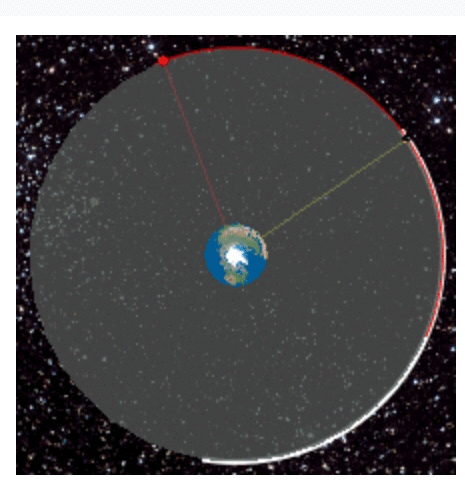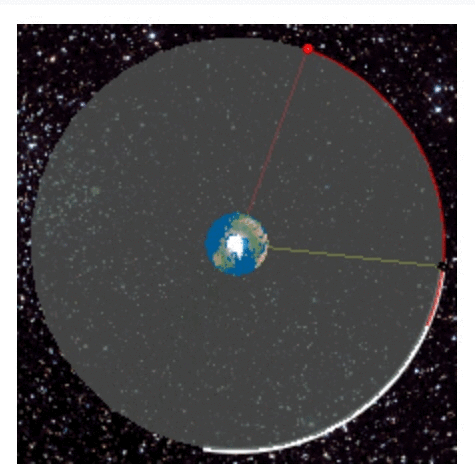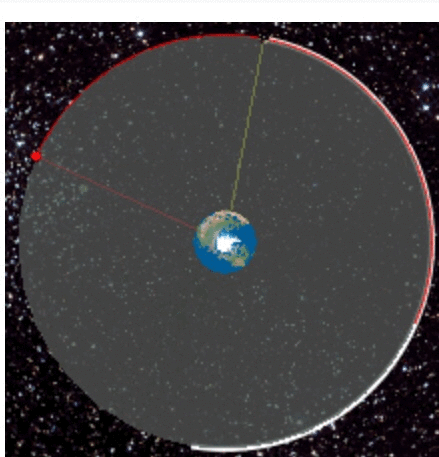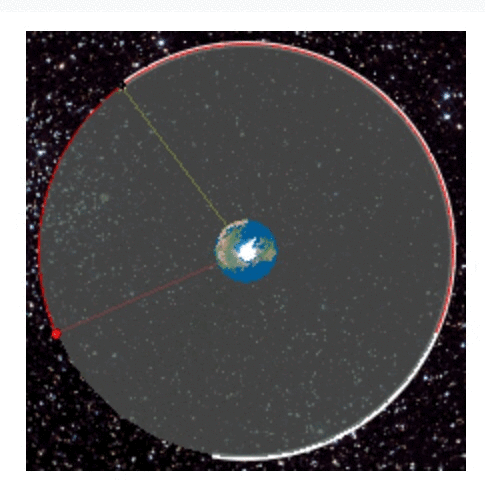It looks like you're using an Ad Blocker.
Please white-list or disable AboveTopSecret.com in your ad-blocking tool.
Thank you.
Some features of ATS will be disabled while you continue to use an ad-blocker.
share:
originally posted by: InfiniteTrinity
a reply to: neutronflux
And you didn’t answer....
What part of "no this is not false" eludes your brain?
Whats this one 4 times now?
Are you feeling allright?
So by definition geostationary/ geosynchronous satellites have a curved trajectory.
Now..
How is the orbital velocity of 1.91 miles a second not the right velocity to keep a satellite in orbit 22,236 mi above the earth?
Geostationary orbit
en.m.wikipedia.org...
A geostationary orbit, often referred to as a geosynchronous equatorial orbit[1] (GEO), is a circular geosynchronous orbit 35,786 km (22,236 mi) above Earth's equator and following the direction of Earth's rotation. An object in such an orbit appears motionless, at a fixed position in the sky, to ground observers. Communications satellites and weather satellites are often placed in geostationary orbits, so that the satellite antennas (located on Earth) that communicate with them do not have to rotate to track them, but can be pointed permanently at the position in the sky where the satellites are located. Using this characteristic, ocean-color monitoring satellites with visible and near-infrared light sensors (e.g. GOCI) can also be operated in geostationary orbit in order to monitor sensitive changes of ocean environ
a reply to: InfiniteTrinity
And...
And...
A geostationary orbit is a particular type of geosynchronous orbit, which has an orbital period equal to Earth's rotational period, or one sidereal day (23 hours, 56 minutes, 4 seconds). Thus, the distinction is that, while an object in geosynchronous orbit returns to the same point in the sky at the same time each day, an object in geostationary orbit never leaves that position. Geosynchronous orbits move around relative to a point on Earth's surface because, while geostationary orbits have an inclination of 0° with respect to the Equator, geosynchronous orbits have varying inclinations and eccentricities.
en.m.wikipedia.org...
a reply to: neutronflux
We have already been over this too. Like I said I didnt claim that it would not have to have this velocity through space to be geostationary.
How is the orbital velocity of 1.91 miles a second not the right velocity to keep a satellite in orbit 22,236 mi above the earth?
We have already been over this too. Like I said I didnt claim that it would not have to have this velocity through space to be geostationary.
edit on 17-8-2019 by InfiniteTrinity because: (no reason given)
a reply to: neutronflux
And what? Already told you 20 times that you can post sources that call it an orbit, all day. Doesnt change the fact that you cant explain how they maintain this curved trajectory through space.
And what? Already told you 20 times that you can post sources that call it an orbit, all day. Doesnt change the fact that you cant explain how they maintain this curved trajectory through space.
originally posted by: InfiniteTrinity
a reply to: neutronflux
And what? Already told you 20 times that you can post sources that call it an orbit, all day. Doesnt change the fact that you cant explain how they maintain this curved trajectory through space.
So. Then geostationary orbit is cited reality with in service geostationary satellites in orbit proving the existence of the technology as backed by provide services and broadcasts from geostationary satellites.
And you have what again?
a reply to: neutronflux
And back to another previously failed argument. When are you going to say something relevant.
And back to another previously failed argument. When are you going to say something relevant.
originally posted by: InfiniteTrinity
a reply to: neutronflux
And back to another previously failed argument. When are you going to say something relevant.
How. When all you do is make claims backed by nothing.....
When source after source is cited. When the technology is in use this second.
Again....
Again...
And Again...
From the earth’s surface. A geostationary satellite appears to be “fixed”. But that same satellite is traveling the “curve” of earth’s gravity well. Orbiting around the center of earth’s gravity well. If you use the earth’s axis as a fixed point of origin, you can solve for the angular momentum of a geostationary / geosynchronous satellite.
You
You guys are hilarious. You keep posting the same dumb contradiction I debunked about 40 times now.
The only thing dumb is that you cannot realize the earth’s rotation has nothing to do with earth’s gravity well. And it’s ”dumb” that you think a satellite cannot be in orbit because it is at a height and speed that matches the earth’s rotation.
First off, the earth’s rotation has nothing to do with the ability of a satellite to orbit. In reality, a satellite does not orbit the center of the earth. A satellite orbits the center of Earth’s gravity well. An orbiting satellite could careless if the earth was rotating, and at what speed.
What is gravity?
spaceplace.nasa.gov...
Second: Why can you not get through your head a geostationary/ geosynchronous still obits the earth. It’s just at a speed that keeps it above a specific point and n earth. But a geostationary / geosynchronous satellite is still traveling around earth’s gravity well.
Geostationary orbit
en.m.wikipedia.org...
A geostationary orbit, often referred to as a geosynchronous equatorial orbit[1] (GEO), is a circular geosynchronous orbit 35,786 km (22,236 mi) above Earth's equator and following the direction of Earth's rotation. An object in such an orbit appears motionless, at a fixed position in the sky, to ground observers. Communications satellites and weather satellites are often placed in geostationary orbits, so that the satellite antennas (located on Earth) that communicate with them do not have to rotate to track them, but can be pointed permanently at the position in the sky where the satellites are located. Using this characteristic, ocean-color monitoring satellites with visible and near-infrared light sensors (e.g. GOCI) can also be operated in geostationary orbit in order to monitor sensitive changes of ocean environments.
a reply to: neutronflux
And back to the 4 other previously failed arguments about stuff I didnt claim. Bye Neutronflux.
Geostationary satellites debunked.
No opposition.
And back to the 4 other previously failed arguments about stuff I didnt claim. Bye Neutronflux.
Geostationary satellites debunked.
No opposition.
edit on 17-8-2019 by InfiniteTrinity because: (no reason given)
originally posted by: InfiniteTrinity
a reply to: neutronflux
And back to the 4 other previously failed arguments. Bye Neutronflux.
Geostationary satellites debunked.
No opposition.
Whole other article for you to quote, debunk with your well laid out arguments, and riveting use of cited evidence and facts..
How to get a satellite to geostationary orbit
www.planetary.org...
edit on 17-8-2019 by neutronflux because: Added and fixed
a reply to: neutronflux
Oh, and this,
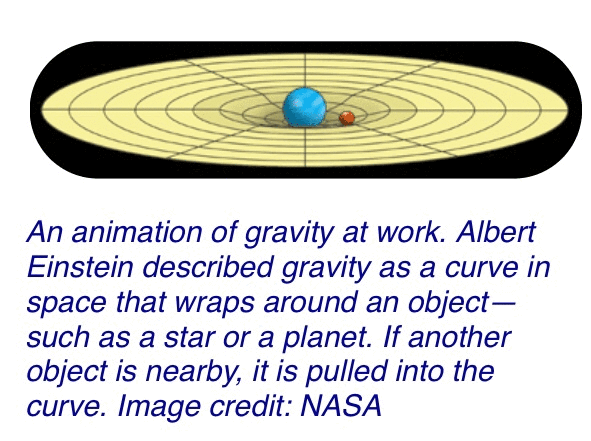
Rofl, a hilarious CONCEPTUAL model.
So I guess space does have a universal down direction, judging by that heavy Earth pushing down on that field that it is sitting on, apparently.
Cant post anything without a hilarious contradiction.
Oh, and this,

Rofl, a hilarious CONCEPTUAL model.
So I guess space does have a universal down direction, judging by that heavy Earth pushing down on that field that it is sitting on, apparently.
Cant post anything without a hilarious contradiction.
edit on 17-8-2019 by InfiniteTrinity because: (no reason given)
a reply to: InfiniteTrinity
You might try some research before trying to act “smart”
Soo, let’s see...
There’s that classical well developed logical argument backed by cited sources and cited evidence.
Nope, gravity’s effect on space to create a gravity well. “A gravity well is the pull of gravity that a large body in space exerts.”
Nope again. What field? Earth’s mass resulting in gravity creating a well in space. So. The concept drawing in not earth pushing down a field. It is pushing down into space.
You might try some research before trying to act “smart”
What is a gravity well?
www.qrg.northwestern.edu...
A gravity well is the pull of gravity that a large body in space exerts. The larger the body (the more mass) the more of a gravity well it has. The Sun has a large (or deep) gravity well. Asteroids and small moons have much shallower gravity wells. Anything on a planet or moon is considered to be at the bottom of the gravity well. Entering space from the surface of a planet or moon means climbing out of the gravity well, something that often takes a huge amount of energy. The larger a planet or moon's gravity well is, the more energy it takes to achieve escape velocity and blast a ship off of it.
Soo, let’s see...
Rofl, a hilarious CONCEPTUAL model.
There’s that classical well developed logical argument backed by cited sources and cited evidence.
So I guess space does have a universal down direction,
Nope, gravity’s effect on space to create a gravity well. “A gravity well is the pull of gravity that a large body in space exerts.”
judging by that heavy Earth pushing down on that field.
Nope again. What field? Earth’s mass resulting in gravity creating a well in space. So. The concept drawing in not earth pushing down a field. It is pushing down into space.
edit on 17-8-2019 by neutronflux because: Added and fixed
a reply to: InfiniteTrinity
So...
No agreements against the article...
So...
No agreements against the article...
How to get a satellite to geostationary orbit
www.planetary.org...
a reply to: InfiniteTrinity
You
Actually, try attraction between two objects
You
So I guess space does have a universal down direction,
Actually, try attraction between two objects
How does gravity work?
We know that it causes any two objects in the universe to be drawn to one another.
science.howstuffworks.com...
a reply to: InfiniteTrinity
Your posts are so shameless, even turbo didn’t have the heart for his/her usual weekend rant.......
Your posts are so shameless, even turbo didn’t have the heart for his/her usual weekend rant.......
a reply to: neutronflux
So apart from your drawing showing a down direction in space, you are literally saying there is a down direction in space.
So space is below the Earth, and the Earth is pushing down on it. Got it.
Gravity well debunked.
Geostationary orbits debunked.
The concept drawing in not earth pushing down a field. It is pushing down into space.
So apart from your drawing showing a down direction in space, you are literally saying there is a down direction in space.
So space is below the Earth, and the Earth is pushing down on it. Got it.
Gravity well debunked.
Geostationary orbits debunked.
edit on 18-8-2019 by InfiniteTrinity because: (no reason given)
originally posted by: neutronflux
a reply to: InfiniteTrinity
So...
No agreements against the article...
How to get a satellite to geostationary orbit
www.planetary.org...
A Geostationary Orbit (GSO) is a geosynchronous orbit with an inclination of zero, meaning, it lies on the equator.
A geostationary sat does not orbit the equator. It is stationary above a point on the equator.
Geostationary orbits debunked.
a reply to: InfiniteTrinity
I really have to ask, do you even have an argument beyond "I don't understand it so it's fake"? Honestly, you not being able to understand highschool level physics isn't proof of anything other than your poor education. Now do you have any evidence for anything you say or do you just like spouting ignorant nonsense and then saying "debunked"?
I really have to ask, do you even have an argument beyond "I don't understand it so it's fake"? Honestly, you not being able to understand highschool level physics isn't proof of anything other than your poor education. Now do you have any evidence for anything you say or do you just like spouting ignorant nonsense and then saying "debunked"?
originally posted by: InfiniteTrinity
Lets ask Google. Google! Why dont satellites fall back to Earth?
"Because they are orbiting Earth."
Google! Why dont geostationary satellites fall back to Earth?
".....Earth is the third planet in our solar system, it's.."
Geostationary satellites are orbiting the Earth. They are just doing so at the same speed Earth rotates, and at a distance that allows the orbit at that speed to be a stable one.
The orbital mechanics of the satellite don't really care if the Earth is rotating at the same speed of the orbit. The Earth could be not rotating at 1/4 the speed it does now and the satellite could still orbit at the speed it currently does. Or the Earth could be rotating 4 times faster than it does now and that satellite could still orbit at the speed it currently does.
Of course, in those two cases it would no longer be orbiting at same speed as earth, so it would no longer be geostationary, but that is a moot point.
The point is that a geostationary satellite does in fact orbit Earth.
edit on 2019/8/18 by Box of Rain because: (no reason given)
a reply to: Box of Rain
They are not orbiting the Earth. They dont move relative to the Earth. Maybe you missed that. It was only pointed out 200 times.
Geostationary satellites are orbiting the Earth. They are just doing so at the same speed Earth rotates.
They are not orbiting the Earth. They dont move relative to the Earth. Maybe you missed that. It was only pointed out 200 times.
The point is that a geostationary satellite does in fact orbit Earth.
a reply to: captainpudding
Can you say something relevant?
You should know by now what you need to explain to save your geostationary orbits. Go ahead.
Can you say something relevant?
You should know by now what you need to explain to save your geostationary orbits. Go ahead.
edit on 18-8-2019 by InfiniteTrinity because: (no
reason given)
new topics
-
Aerospace’s Secret Search For Antigravity
Science & Technology: 22 minutes ago -
Limits on Technology
Science & Technology: 1 hours ago -
20 Supporters Seated Behind Trump Onstage Rushed to Hospital
2024 Elections: 3 hours ago -
FBI says Iran sent hacked Trump info to Biden campaign
US Political Madness: 4 hours ago -
There would be no political madness, if We the People know the Truth
US Political Madness: 6 hours ago -
Gavin Newsom passes law against deepfake political ads
Politicians & People: 9 hours ago -
I have Three Questions .
US Political Madness: 11 hours ago
top topics
-
20 Supporters Seated Behind Trump Onstage Rushed to Hospital
2024 Elections: 3 hours ago, 15 flags -
American Troops React to Kamala Harris Claim of No U.S. Troops in Combat Zones
Propaganda Mill: 15 hours ago, 11 flags -
New electoral college model, according to Nate Silver (no tossup).
2024 Elections: 14 hours ago, 11 flags -
FBI says Iran sent hacked Trump info to Biden campaign
US Political Madness: 4 hours ago, 10 flags -
Teamsters Has Announced It Will Not Endorse Any 2024 Presidential Candidate
2024 Elections: 15 hours ago, 7 flags -
Gavin Newsom passes law against deepfake political ads
Politicians & People: 9 hours ago, 7 flags -
There would be no political madness, if We the People know the Truth
US Political Madness: 6 hours ago, 6 flags -
I have Three Questions .
US Political Madness: 11 hours ago, 4 flags -
Limits on Technology
Science & Technology: 1 hours ago, 3 flags -
Aerospace’s Secret Search For Antigravity
Science & Technology: 22 minutes ago, 0 flags
active topics
-
Limits on Technology
Science & Technology • 11 • : BeyondKnowledge3 -
Why Donald J Trump is a threat to Democracy and Normal Feedoms
US Political Madness • 71 • : covent -
FBI says Iran sent hacked Trump info to Biden campaign
US Political Madness • 22 • : theatreboy -
20 Supporters Seated Behind Trump Onstage Rushed to Hospital
2024 Elections • 22 • : TheLieWeLive -
There would be no political madness, if We the People know the Truth
US Political Madness • 11 • : Annee -
New electoral college model, according to Nate Silver (no tossup).
2024 Elections • 11 • : Irishhaf -
Aerospace’s Secret Search For Antigravity
Science & Technology • 0 • : onestonemonkey -
Gavin Newsom passes law against deepfake political ads
Politicians & People • 12 • : putnam6 -
Cell phones exploding in Lebanon mass casualties
Middle East Issues • 56 • : StudioNada -
Who is going to be number three
US Political Madness • 58 • : TinfoilTophat

